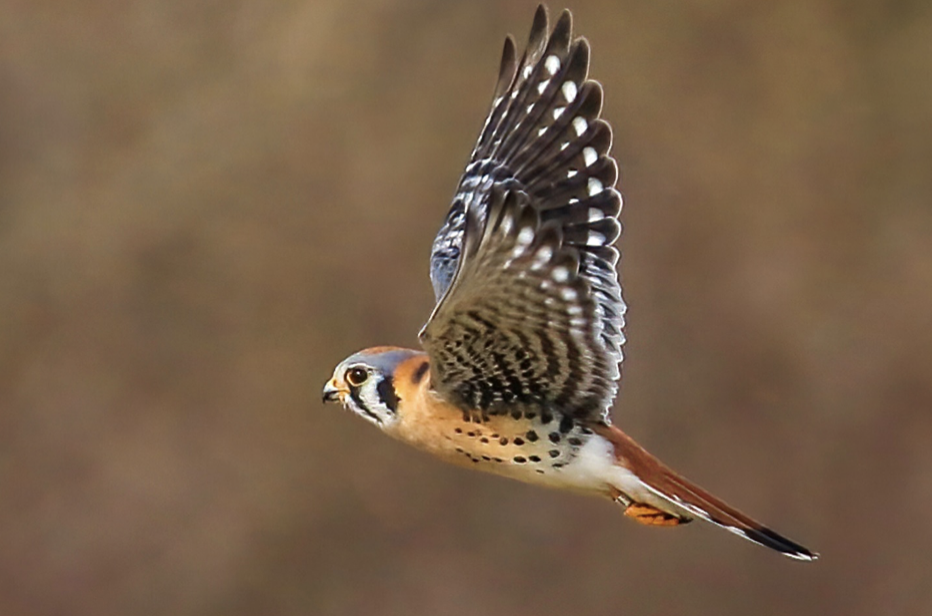Photo: American Kestrel, Matt Felperin
Fall migration through northern Virginia is by no means over, but the numbers of birds traveling to, as well as passing over and through, our area is on the decline. Some of us may now stop obsessively checking BirdCast daily to see what we may anticipate passing through overnight. But, that doesn’t mean that we should stop obsessing about migration and the challenges it presents to North American birds.
The last few years have seen an explosion of data collection and data management tools that are giving us a more detailed view of migration than we have ever had before. The Bird Migration Explorer is an online guide to the journeys of 458 species of birds generated from data consolidated from multiple sources. It is available as a free interactive platform through National Audubon Society, but was developed through a partnership among Audubon and Birds Canada, Bird Conservancy of the Rockies, Bird Genoscape Project, BirdLife International, Cornell Lab of Ornithology, Esri, Georgetown University, Movebank, and the Smithsonian Migratory Bird Center.
Spend a little time on the site and you can see what information is available and how the information can help focus conservation and advocacy efforts in the North America.
Look, for example, at the maps for the American Kestrel, a bird facing significant challenges in our area because of vanishing meadows. The base map that underlies the migration and connection maps shows the bird’s summer, winter, and year-round ranges, information that is generally available from field guides, both printed and online. That data for the explorer comes from eBird at the Cornell Lab, BirdLife International, and Audubon.
American Kestrel, Matt Felperin
But the migration map provides more. Overlaid on that base, using information from the same sources, is a graphical representation of abundance of the species throughout the yearly cycle. While the map shows moderate abundance in some areas of the country, it clearly shows the perilous state of the bird in our area. And what seems almost magical, the map includes the route of tracked birds: the routes are generated from two studies that tracked 10 individual birds, data shared by researchers and stored on Movebank and Motus. There’s also a link to a 2020 article about the species’ decline.
But there’s even more! Species connection maps show where tagged birds of one species have been re-encountered as they traveled across the hemisphere. Connections are derived from millions of re-encounter observations from tracking, banding, automated radio telemetry, and genetics data. A mouse click on a location displays the locations the species traveled to and the number of individuals that have traveled between the locations. The map shows birds from our area showing up further up the coast into Canada, down to the east coast of Florida, and inland to Georgia. The kestrel map shows connections for 1,943 individual birds, data from four studies stored on Movebank, the USGS Bird Banding Lab, Motus, and the Bird Genoscape Project.
But how does all this information help direct our conservation efforts? Click over to the conservation challenges maps and look for our area. The data for these maps come from weekly distribution data from Cornell’s eBird. The map provides a visual image of different challenges in the area throughout the year. Conservation challenges such as suburban development, roads, and power lines fluctuate in intensity during the year depending on the relative abundance of birds in the area—showing higher exposure and higher abundance during migration as birds pass through our developing landscape.
The data indicate that ASNV’s current focus on conservation and advocacy efforts is appropriate—that is, a focus on preserving and maintaining habitat, supporting wildlife corridors and responsibly sited bike paths, creating bird-friendly habitat in developed areas, encouraging developers to use bird-friendly glass in construction, educating the public about turning off lights during migration, and working to limit exposure of birds to predation by free-roaming cats. Those efforts can help our local wildlife as well as vulnerable migrants.
Another takeaway from the exercise of exploring the Bird Migration Explorer is the importance of citizen science to bird conservation. Identification of the relative abundance of birds throughout the calendar year and throughout the Americas provides the base for the migratory bird initiative. Continuing development of citizen science data, as well as analysis of the available data over time, also can show important trends that can further focus all of our efforts.
On the issue of changing trends over time, you can look forward to an article in next month’s Potomac Flier on the recently-updated State of the Birds Report 2022 (released on October 12, 2022). The report is available at StateoftheBirds.org. Until then, take a look at this month’s “President’s Corner” on how ASNV can use multiple data sources to focus its efforts on behalf of the birds and our local environment.
Enjoy exploring!


